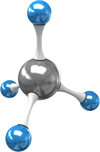Resource Evaluation Program
Gas Hydrates
 |
Gas hydrates are ice-like crystalline substances occurring in nature where a solid water lattice accommodates gas molecules (primarily methane, the major component of natural gas) in a cage-like structure, also known as clathrate. These form under conditions of relatively high pressure and low temperatures, such as those found in the shallow subsurface under many of the world's deepwater oceans. One cubic foot of hydrate at reservoir temperature and pressure yields approximately 160 cubic feet of gas at atmospheric temperature and pressure. The amount of natural gas in methane hydrate worldwide is estimated to be far greater than the entire world's conventional natural gas resources.
BOEM, in conjunction with the United States Geological Survey, industry, and numerous universities, has invested significant resources to date in an effort to better understand methane hydrates. With the demand for natural gas expected to increase significantly over the next 10 to 20 years, methane gas hydrates, which are likely present on the OCS in significant quantities, may be a potential source to meet both industrial and domestic needs for natural gas.
 |